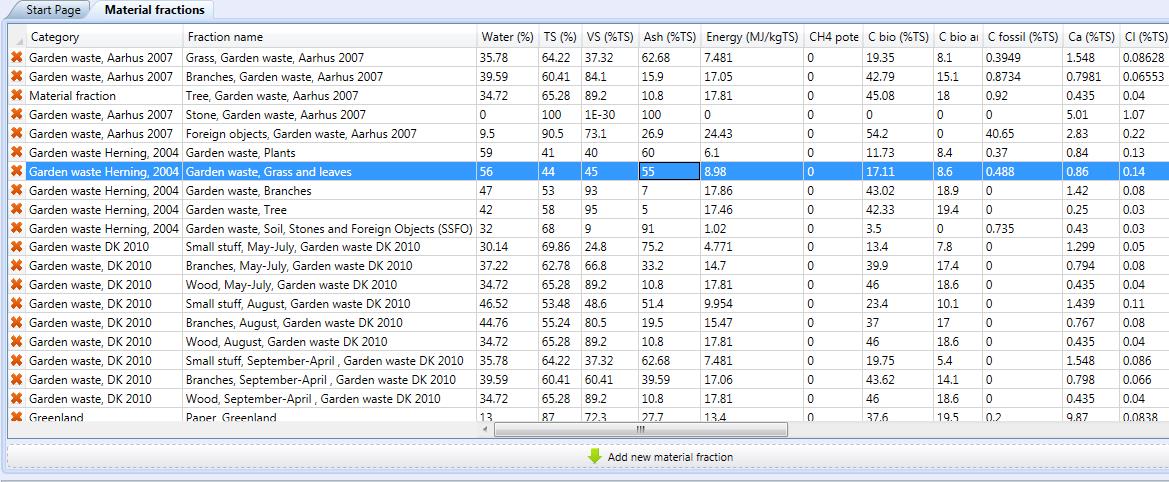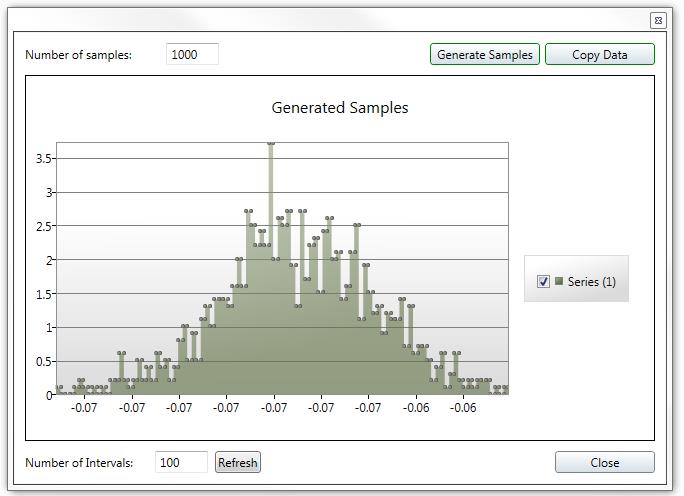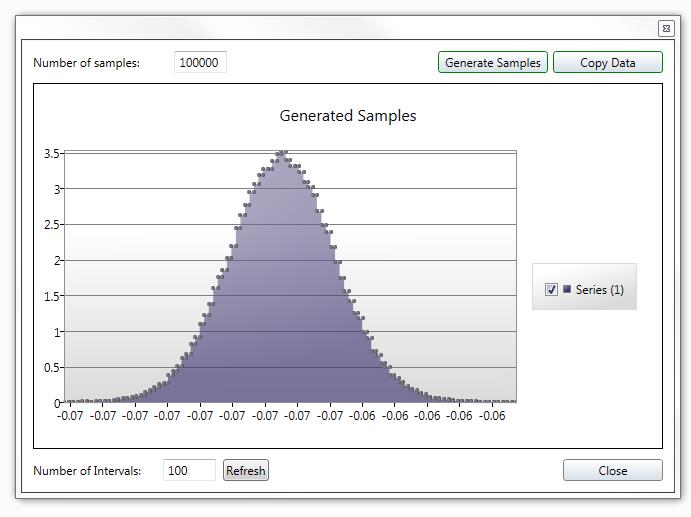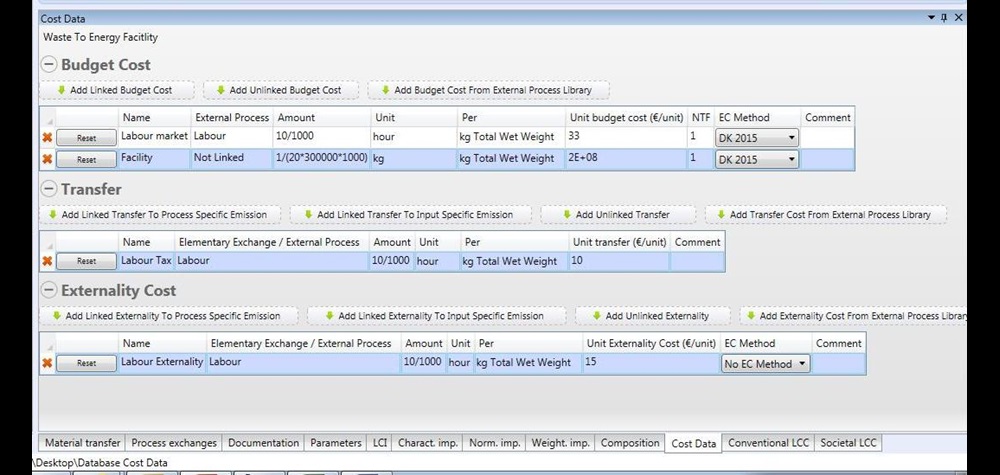EASETECH is a LCA software dedicated to modelling of environmental technologies developed by the Technical University of Denmark. The software was released in 2013, and is continuously updated with newer data and additional tools. A more detailed description of how the software works can be found in Clavreul et al., 2014.
The following gives a description of the two key features that make EASETECH unique compared to other LCA software, namely: the use of material fractions and a toolbox of process modules that can be combined freely.
EASETECH allows the user to define a generic reference flow not as a single material but as a sum of different material fractions that are tracked individually through the system. Each fraction is characterised in terms of chemical composition (e.g. carbon or mercury content), as well as fraction-specific parameters (i.e. water content, heating value, methane potential) as shown in Figure 1.

Figure 1: Overview of the material fractions
Environmental technologies can easily be modelled through the use of a toolbox of template material processes, which are defined as the processes that handle material and substance flows in the software. Since flows need to be handled in different ways, different templates have been created in EASETECH and are listed in Table 1. The toolbox offers a set of generic process modules to create, modify and split flows. In addition to this, more specific material processes have been developed to model anaerobic digestion, landfill gas generation, leachate generation and the application of processed waste on agricultural land, as the initial focus of this model was on waste management. In the example of landfill gas generation, a specific module was developed which models first order degradation of organic matter and whose output details the landfill gas composition over time. The software is provided with a predefined set of technologies for all commonly used treatment options for solid waste. Most of these technologies consist of grouped material processes to form the actual treatment process.
Table 1: Material processes templates available in EASETECH
|
Template name
|
Description
|
|
Material generation
|
Create a material flow using a library of material fractions
|
|
Energy generation
|
Create an energy flow (with associated mass and
substances
|
|
Material generation - manual
|
Create a material flow composed of fractions that are not pre-defined but are manually compiled
|
|
Basic process
|
Keep the flow unchanged
|
|
Water content
|
Modify the water content of the input flow
|
|
Change of energy content
|
Modify the energy content of the input flow
|
|
Addition of substances
|
Add substances to the input flow
|
|
Mass transfer
|
Split the input flow according to total mass
|
|
Substance transfer
|
Split the input flow according to different properties (two possible data inputs: fraction specific or default)
|
|
Mass transfer over years
|
Split the input flow according to years
|
|
Anaerobic digestion
|
Produce a gas and a digestate out of an anaerobic digester
|
|
Landfill gas generation
|
Degrade organic matter according to exponential first-order decay, creating a landfill gas and remaining waste
|
|
Leachate generation
|
Define leachate generation and remaining waste
|
|
Use on land
|
Distribute C, N and P from the input flow and create an avoided flow
|
|
No output
|
Has no output
|
|
Emissions to the environment
|
Translates input flow into release into an environmental compartment
|
|
Multiple input
|
This process is similar to “Basic”, but the process accepts multiple inputs.
|
In order to graphically illustrate some of the potentiality of the software, Figure 2 shows its user interface, while Figure 3 and Figure 4 display how a generic anaerobic digestion and a landfill can be modelled. The program uses data contained in catalogues and in the scenario to compute results in five different layers: material flow compositions, life cycle inventory (LCI), characterised, normalised and weighted impacts. The first layer keeps track of all the mass and substance flows. The second layer includes the calculation of the Life Cycle Inventory as the sum of all the external process contribution (e.g. electricity consumption), process-specific and input specific emissions. For more information on characterised, normalised and weighted results, refer to the “Impact assessment” Tab.

Figure 2: EASETECH user interface (1: main window; 2: data input and results display; 2a: material transfer; 2b: process exchanges; 2c: documentation; 2d: LCI; 2e: characterised impacts; 2f: normalised impacts; 2g: weighted impacts; 2h: flow composition; 3: libraries; 3a: material processes; 3b: projects and scenarios; 3c: external processes; 4: catalogues; 4a: material fractions; 4b: elementary exchanges; 4c: impact categories; 4d: LCIA methods; 4e: interfaces; 4f: constants; 4g: material properties).
Uncertainty analysis
The understanding of the results from a Life Cycle Assessment is very limited if not associated with an uncertainty analysis. EASETCH includes few tools developed in order to make the uncertainty analysis easier and quicker. EASETECH allows the use of parameters or formulae using parameters in all input fields. For each parameter the user can specify one value, a list of values or a probability distribution. The user can define, for each parameter, a probability distribution of uniform, triangular, normal or lognormal shapes. For a Monte Carlo simulation, the calculation involves sampling all distributions to obtain a list of values for each parameter (the length of which equals the number of runs) and then running the model with this list of values. Figure 5 shows an example of result of the Monte Carlo simulation by using 1000 and 100000 samples.


Figure 3: Monte Carlo simulation using 1000 and 100000 samples
Life Cycle Costing
Recently, a new tool was added to EASETECH in order to be able to perform both Conventional and Societal Life Cycle Costing (LCC). Economic data associated with each material process can be added in the “cost data” tab (Figure 6). Each cost item should be classified as: 1) budget cost (market goods excluding taxes), 2) transfer (taxes, subsidies, etc.) or 3) externality costs (non-market goods such as damage cost of emissions). This classification is important because each type of LCC include only 2 of this types. While the Conventional and Environmental LCC only account for budget cost and transfers, as they are financial assessments, Societal LCC includes budget cost and externality costs. In the catalog “Emission Price Method”, the user is able to create or edit a method consisting on a set of elementary exchanges with accounting prices used to calculate externality costs in Societal LCC. These accounting prices should represent the damage cost or abatement cost of emissions for a region and time.
EASETECH calculates the following types of LCC:
- Conventional LCC – Gives the results of a financial assessment (Conventional LCC) in which costs are disaggregated into budget cost and transfers.
- Environmental LCC – Gives the results of a financial assessment in parallel with LCA results (to choose between characterized, normalized or weighted results). Cost are disaggregated into budget cost and transfers
- Societal LCC – Gives the results of a welfare economic assessment (socio-economic assessment) in which costs are disaggregated into budget cost (market goods) and externality costs (non-market goods).

Figure 4: example of Cost data
References
Clavreul, J., Baumeister, H., Christensen, T.H., Damgaard, A., 2014. An environmental assessment system for environmental technologies. Environ. Model. Softw. 60, 18–30. doi:10.1016/j.envsoft.2014.06.007